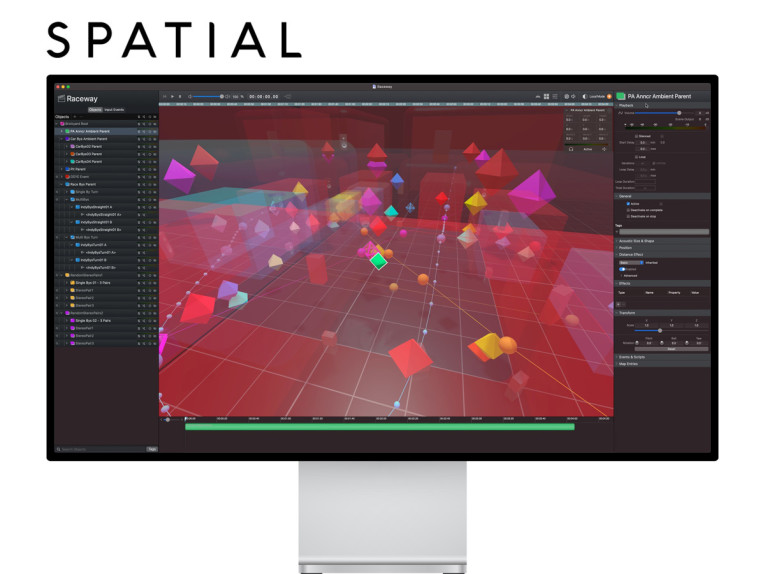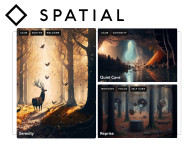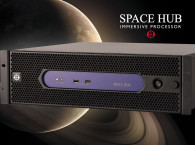
Spatial's leadership team, including CEO Calin Pacurariu (former Apple & Handspring VP), COO Darrell Rodriguez (former President of Lucas Arts), and VP of Product Marketing Raja Haddad (former Apple Watch retail lead & fashion industry exec), will all be promoting this initiative at SXSW 2022. The company plans to democratize 3D sound: "Today, Spatial goes unhinged! Anyone in the world can get started creating sound objects and soundscapes in minutes with license-based access to fully develop and deploy Spatial scenes," the company announces.
For commercial use, Spatial is now offering a simple $10,000/year subscription license, including access to its full platform and library of shared soundscapes, making its previously gated software available to retail, hospitality, museums, estates, venues, hospitals, theme parks and more.
For creative uses, Spatial offers Backstage Pass, a free license that allows creators to design immersive 3D audio environments with Spatial Studio, the company's macOS authoring tool; and Spatial Reality, the real-time performance engine that runs the audio simulation in real world physical spaces. In a model that has worked extremely well for game engines like Unity and Unreal, Spatial is democratizing access to 3D sound design by providing free access to full design and publishing capabilities. This enables a much larger ecosystem of creators to publish dynamic 3D soundscapes directly to Spatial commercial customers for use across a wide variety of spaces and experiences.
"Designing acoustic experiences, at all levels, in all kinds of spaces, with the full power of sound in mind is no longer a millions-of-dollars capability constrained by highly specialized and inflexible systems," says Calin Pacurariu. "We created Spatial to put that power in the hands of everyone, and we're excited to see how our creators and customers build a range of experiences from magically entertaining immersive locations to deeply therapeutic retreats for healthcare worker recovery. Creators around the world are already taking this technology and reshaping the human experience in that infinite universe we call reality."
Since its inception in 2017, Spatial has been on a journey to unlock the full potential of immersive technology to enhance human experience – in real world and everyday environments. From retail stores, hotels and theme parks to work spaces, hospitals and museums, Spatial's audio design platform offers new creative possibilities to enhance environments for meaningful engagement, powerful entertainment, and well-being. Spatial liberates sound design from linear and channel-based audio, allowing users to do things with immersive sound that have never been done before, in places that traditional audio has long forgotten. Running on Macs and iPhones, Spatial is more easily and affordably deployed than existing audio solutions – and scales without constraints.

New Capabilities
After a year of receiving feedback from sound designers, engineers, and technology partners around the world – including Eight, Made Music Studio, Meow Wolf, HealthTunes, Catalyst by Wellstar, Zeitgeist, National Geographic, Nightscape, the California Academy of Arts (CalArts), and the Conservatory of Recording Arts and Sciences (CRAS), among others – Spatial is introducing significant feature improvements that make it easier than ever to design, create, and deploy realistic, interactively dynamic, and flexible 3D sound experiences.
With Spatial's suite of Spatial Studio, Spatial Reality and Spatial Control tools, users can augment any space with natural, immersive sonic experiences that feel completely real, applying layers of sounds that move around a room, seemingly coming from anywhere and everywhere. Spatial soundscapes bring environments to life, evoking emotions, influencing behaviors, and elevating moments. Built around how sound works in nature, the system allows for sound objects to be defined with both natural physics and behaviors: not just position/location, but also realistic size, shape, distance, motion, and speed.
With the announced updates, the Spatial platform further improves critical sound behaviors like loudness, delay, indoor and outdoor distance effects, doppler effect, and more. To make sure users always get the most out of their technology investments, Spatial now offers improved rendering and support for scalable high performance, with Spatial Reality now able to support up to 64 channels of audio on a single Mac mini.
Spatial soundscapes can respond to movement, video, lighting, music, and other inputs that trigger actions. With comprehensive support for inputs and outputs, Spatial offers unlimited potential to create responsive, immersive experiences optimized for specific audiences. Improved and powerful event-driven behaviors, loudness animation and fading, and increased integration with Open Sound Control (OSC) inputs and outputs for dynamic sound scenes, the suite combines timeline-driven, and event-driven content to enable a new level of sound design.
Built for flexibility, Spatial soundscapes can be deployed in any size indoor or outdoor space, and adapted to any speaker configuration. The same scene built in Spatial Studio can reshape itself to any layout and environment. On a quest to eliminate friction from both creative and execution points of view, Spatial latest updates include the new Spatial Headspace tool, allowing a soundscape designer to preview and simulate their target deployment via headphones or stereo speakers; improved adaptation to spaces and interaction with modeling transforms; as well as more expansive support for sound fields coming from traditional immersive formats, via native integration with Steinway Lyngdorf.
Spatial also released today a number of additional tools geared to facilitate initial setup as well as ongoing management. Starting with hands-on account management through a web admin view, and improved, privacy-shielded analytics to better understand the use of Spatial and make improvements going forward. Also improved are logging, warnings, and troubleshooting for enterprise-level stability.
www.spatialinc.com








